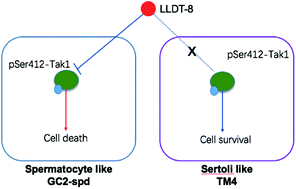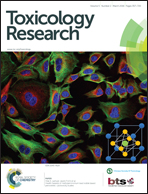Dephosphorylation of Tak1 at Ser412 greatly contributes to the spermatocyte-specific testis toxicity induced by (5R)-5-hydroxytriptolide in C57BL/6 mice†
Abstract
(5R)-5-Hydroxytriptolide (LLDT-8), a novel triptolide derivative, will proceed to phase II clinical trials for the treatment of rheumatoid arthritis and cancer. However, the selection of disease and patients is largely limited by the testis toxicity, yet toxicity mechanisms are still poorly understood. In this study, LLDT-8 dose and time-dependently decreased the testes weight, germinal cell layers and induced abnormal spermatid development. Analysis of the germ cell-specific marker showed that spermatocytes were more sensitive to LLDT-8, which was confirmed by the in vitro sensitivity assay with spermatocyte-like GC-2spd and sertoli-like TM4 cells. In GC-2spd, LLDT-8 induced G1/S arrest and apoptosis. MAPK activity screening identified that TGF-β activated kinase 1 (Tak1) is critical in LLDT-8 induced apoptosis. LLDT-8 reduced the Tak1 protein and dephosphorylated Tak1 at Ser412 in GC-2spd and the testes, but not in TM4. RNAi mediated depletion or pharmacologic inhibition of Tak1 induced apoptosis in GC-2spd. Meanwhile, activating Tak1 rescued up to 50% of the GC-2spd cells from the apoptosis induced by LLDT-8. Altogether, our study firstly revealed the important role of Tak1 in the survival of spermatocytes, and dephosphorylation of Tak1 at Ser412 may contribute to the spermatocyte-specific testis toxicity induced by LLDT-8.



 Please wait while we load your content...
Please wait while we load your content...